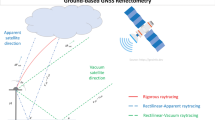Abstract
Multipath is detrimental for both GPS positioning and timing applications. However, the benefits of GPS multipath for reflectometry have become increasingly clear for soil moisture, snow depth, and vegetation growth monitoring. Most multipath forward models focus on the code modulation, adopting arbitrary values for the reflection power, phase, and delay, or they calculate the reflection delay based on a given geometry and keep reflection power empirically defined. Here, a fully polarimetric forward model is presented, accounting for right- and left-handed circularly polarized components of the GPS broadcast signal and of the antenna and surface responses as well. Starting from the fundamental direct and reflected voltages, we have defined the interferometric and error voltages, which are of more interest in reflectometry and positioning applications. We examined the effect of varying coherence on signal-to-noise ratio, carrier phase, and code pseudorange observables. The main features of the forward model are subsequently illustrated as they relate to the broadcast signal, reflector height, random surface roughness, surface material, antenna pattern, and antenna orientation. We demonstrated how the antenna orientation—upright, tipped, or upside-down—involves a number of trade-offs regarding the neglect of the antenna gain pattern, the minimization of CDMA self-interference, and the maximization of the number of satellites visible. The forward model was also used to understand the multipath signature in GPS positioning applications. For example, we have shown how geodetic GPS antennas offer little impediment for the intake of near-grazing reflections off natural surfaces, in contrast to off metal, because of the lack of diversity with respect to the direct signal—small interferometric delay and Doppler, same sense of polarization, and similar direction of arrival.









Similar content being viewed by others
References
Beckmann P, Spizzichino A (1963) The scattering of electromagnetic waves from rough surfaces. Pergamon (Republished by Artech, 1987), p 503
Bourlier C, Pinel N, Fabbro V (2006) Illuminated height PDF of a random rough surface and its impact on the forward propagation above oceans at grazing angles. 2006 First European Conference on Antennas and Propagation. IEEE, pp 1–6. doi:10.1109/EUCAP.2006.4584894
Fontana RD, Cheung W, Novak PM, Stansell TA (2001) The new L2 civil signal. Proc ION GPS. Institute of Navigation, Salt Lake City, pp 617–631
Georgiadou Y, Kleusberg A (1988) On carrier signal multipath effects in relative GPS positioning. Manuscr Geodaet 12:172–179
GPSD-USAF (2011) Navstar GPS space segment/navigation user segment interfaces, Revision F (IS-GPS-200F). p 210
Langley RB (1997) GPS receiver system noise. GPS World 8:40–45
Larson KM, Small EE, Gutmann ED, Bilich AL, Braun JJ, Zavorotny VU (2008) Use of GPS receivers as a soil moisture network for water cycle studies. Geophys Res Lett 35:L24405. doi:10.1029/2008GL036013
Larson KM, Gutmann ED, Zavorotny VU, Braun JJ, Williams MW, Nievinski FG (2009) Can we measure snow depth with GPS receivers? Geophys Res Lett 36:L17502. doi:10.1029/2009GL039430
Lestarquit L, Nouvel O (2012) Determining and measuring the true impact of C/A code cross-correlation on tracking—application to SBAS georanging. Proc IEEE/ION PLANS. IEEE, pp 1134–1140. doi:10.1109/PLANS.2012.6236968
Löfgren JS, Haas R, Scherneck H-G, Bos MS (2011) Three months of local sea level derived from reflected GNSS signals. Radio Sci 46:1–12. doi:10.1029/2011RS004693
Milligan TA (2005) Modern antenna design. Wiley-IEEE, New Jersey, p 632
Misra P, Enge P (2006) Global positioning system: signals, measurements, and performance, 2nd ed. Ganga-Jamuna, p 569
Rodriguez-Alvarez N, Bosch-Lluis X, Camps A, Aguasca A, Vall-llossera M, Valencia E, Ramos-Perez I, Park H (2011a) Review of crop growth and soil moisture monitoring from a ground-based instrument implementing the interference pattern GNSS-R technique. Radio Sci 46:1–11. doi:10.1029/2011RS004680
Rodriguez-Alvarez N, Camps A, Vall-llossera M, Bosch-Lluis X, Monerris A, Ramos-Perez I, Valencia E, Marchan-Hernandez JF, Martinez-Fernandez J, Baroncini-Turricchia G, Perez-Gutierrez C, Sanchez N (2011b) Land geophysical parameters retrieval using the interference pattern GNSS-R technique. IEEE Trans Geosci Remote Sens 49:71–84. doi:10.1109/TGRS.2010.2049023
Small EE, Larson KM, Braun JJ (2010) Sensing vegetation growth with reflected GPS signals. Geophys Res Lett 37:L12401. doi:10.1029/2010GL042951
Spilker JJ, Enge PK, Parkinson BW, Axelrad P (1996) Global positioning system: theory and applications. AIAA, p 781
Treuhaft RN, Lowe ST, Zuffada C, Chao Y (2001) 2-cm GPS altimetry over Crater Lake. Geophys Res Lett 28:4343. doi:10.1029/2001GL013815
Woo KT (2000) Optimum semicodeless carrier-phase tracking of L2. Navig 47:82–99
Zavorotny VU, Voronovich AG (2000) Scattering of GPS signals from the ocean with wind remote sensing application. IEEE Trans Geosci Remote Sens 38:951–964. doi:10.1109/36.841977
Zavorotny VU, Larson KM, Braun JJ, Small EE, Gutmann ED, Bilich AL (2010) A physical model for GPS multipath caused by land reflections: toward bare soil moisture retrievals. IEEE J Sel Topics Appl Earth Observ 3:100–110. doi:10.1109/JSTARS.2009.2033608
Acknowledgments
This research was supported by NSF (EAR 0948957, AGS 0935725). Mr. Nievinski has been supported by a Capes/Fulbright Graduate Student Fellowship and a NASA Earth System Science Research Fellowship. Reviewers and the editor are gratefully acknowledged for their comments.
Author information
Authors and Affiliations
Corresponding author
Rights and permissions
About this article
Cite this article
Nievinski, F.G., Larson, K.M. Forward modeling of GPS multipath for near-surface reflectometry and positioning applications. GPS Solut 18, 309–322 (2014). https://doi.org/10.1007/s10291-013-0331-y
Received:
Accepted:
Published:
Issue Date:
DOI: https://doi.org/10.1007/s10291-013-0331-y




